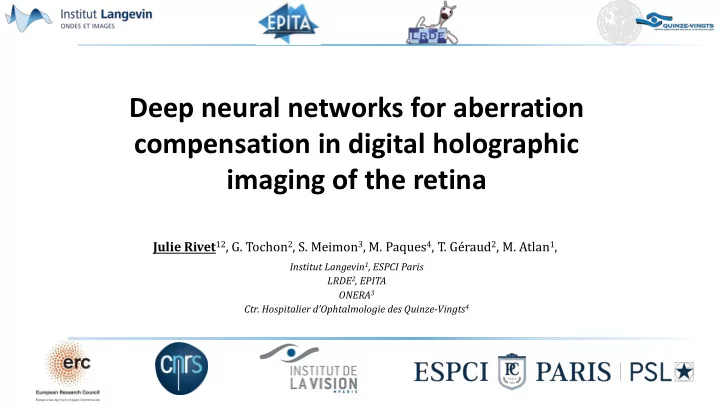

Deep neural networks for aberration compensation in digital holographic imaging of the retina Julie Rivet 12 , G. Tochon 2 , S. Meimon 3 , M. Paques 4 , T. Géraud 2 , M. Atlan 1 , Institut Langevin 1 , ESPCI Paris LRDE 2 , EPITA ONERA 3 Ctr. Hospitalier d’Ophtalmologie des Quinze-Vingts 4
Introduction • Project: holographic imaging of the retina in real-time • Problem: aberrations created by cornea disturb holographic imaging • Fast estimation and correction of aberrations are necessary
Outline I. I. Digital holographic imaging Digital holographic imaging II. Aberration estimation II. Aberration estimation III. Prospects III. Prospects 3
Setup and image formation Block of interferograms Block of holograms Block of spectrograms Real-time processing with Holovibes 𝑧 𝑧 𝑧 Angular spectrum Time Fourier transform 𝑢 𝑢 𝝃 propagation 𝑦 𝑦 𝑦 𝑨 = 0 𝑨 = 0 𝑨 Sensor plane Image plane Image plane 4
Doppler images Fluctuation spectrum Block of spectrograms calculation 𝑧 𝝃 𝑦 𝑨 = 0 Image plane Holography Doppler images taken and processed by Léo Puyo from Institut Langevin 5
Impact of aberrations from cornea Goal: aberration correction in real-time 6
Outline I. Digital holographic imaging II. Aberration estimation III. Prospects 7
Astigmatism estimation by image-based optimization Minimization of Aberrated image Corrected image Aberrated wavefront Astigmatism 0 ° , 45 ° and 90 ° 8 Holography Doppler images taken and processed by Léo Puyo
Aberration measurement with digital wavefront sensor Principle of Shack-Hartmann wavefront sensor • Each aberration corresponds to one degree of Zernike polynomial (one mode). • M reference matrix of size n subapertures x n modes • Y = MA , where Y is observation vector ( n subapertures x 1 ) and A is amplitude vector ( n modes x 1 ) • Then M is reversed to find A. Simulations Tests on real data in progress … 9
Aberration compensation with deep neural network Hologram Interferograms Processings & Images of the reconstruction corrections retina Deep neural network U-Net Ronneberger, et al. "U-net: Convolutional networks for biomedical image segmentation." International Conference on Medical image computing and computer- assisted intervention . Springer, input : image Cham, 2015. output : image 10
Hologram rendering with a U-Net UNet Training on 28 000 Input/output image couples Input: aberrated hologram Reconstructed image Ground truth Training : one defocus Reconstruction : the same amount of defocus Results : good correction 11
Hologram rendering with a U-Net N=30 Time sequence of Aberration compensation Ground truth Aberrated image aberrations taken from through deep learning real eyes with 30 different types of Training : one average aberration aberrations Reconstruction : variety of aberrations close to the avg. Results : U-Net not suitable as is to learn a diversity of aberrators Jessica Jarosz, Pedro Mecê, Jean-Marc Conan, Cyril Petit, Michel Paques, and Serge Meimon, "High temporal resolution aberrometry in a 50-eye population and implications for adaptive 12 optics error budget," Biomed. Opt. Express 8, 2088-2105 (2017)
Outline I. Digital holographic imaging II. Aberration estimation III. Prospects 13
Prospects What if the aberrator has a large number of degrees of freedom? 14
Cataracts compensation using deep neural networks Increase of # of degrees of freedom N=1 N=30 N=100000 Training : one random phase screen filtered by gaussian filter ( σ =0,4) Reconstruction : variety of phase screens « close » to the one used for training Issue : UNET not suitable « as is » to learn a diversity of « aberrators » Aberrated image Aberration compensation Ground truth through deep learning 15
To go further Work on the training database: • With a large amount of images with several types of complex objects , increasing the degrees of freedom to correct more and more aberrations. • What if the object is the simplest one ? 16
Digital Gabor hologram rendering with deep learning Angular spectrum propagation Collection of random Synthetic interferogram points Synthetic magnitude hologram For training database 17
Digital Gabor hologram rendering with deep learning With simulated images Synthetic interferogram Reconstructed hologram Synthetic magnitude hologram with neural networks 18
Digital Gabor hologram rendering with deep learning With real data (worms) Experimental interferogram Reconstructed hologram Magnitude hologram with neural networks Data courtesy of Stéphanie Rind from Institut Langevin 19
Thank you ! Contact: julie.rivet@espci.fr Funding: European Research Council (ERC Helmholtz, grant agreement #610110)
Digital Gabor hologram rendering with deep learning With real data (worms) Experimental interferogram Reconstructed hologram Magnitude hologram with neural networks Data courtesy of Stéphanie Rind from Institut Langevin 21
Aberrations 22
Recommend
More recommend